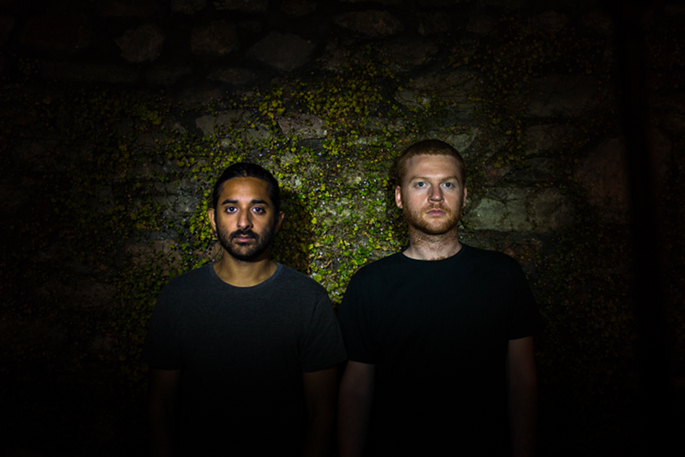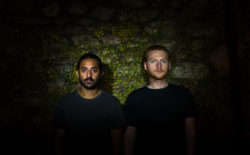The Semibreve Festival takes place in Portugal this week, October 4-6.
Its impressive line-up is focussed on audio-visual performance and the experimental fringe of electronic music, with sets scheduled from the likes of Ben Frost, Vladislav Delay & AGF, Pole & P.MA, Ryoji Ikeda and Jacob Kirkegaard. Britain is represented by Emptyset, the Bristol-orbiting duo of James Ginzburg and Paul Purgas whose studio experiments, and increasingly their live performances too, have exploited the fertile interzone betwene techno, sound-art and noise, earning comparisons with the likes of Pan Sonic and landing them a new 12″ release on Raster-Noton.
Ahead of their set at Semibreve, where they’ll be joined by visual collaborator Joanie Lemercier, FACT collared Emptyset for a quick catch-up.
“After listening to a mediocre orchestral performance in Bristol Cathedral, we started thinking about the idea of using a space as a signal processor.”
 How are you? What are you up to at the moment?
How are you? What are you up to at the moment?
“We’re very good, sat in Seattle airport waiting to fly back to the UK after Decibel festival here, where we performed with Byetone and Kanding Ray, which was a great event. At the moment we are focussing on a third full studio album and an installation we’re doing for the Architecture Foundation in London in November.”
What were the origins of [Emptyset’s most recent album] Medium? Where did the idea to record at Woodchester Mansion in Gloucestershire come from?
“Medium was born out of experiments we were running in the studio based around using various objects and mic set-ups as signal processors. Up until that point we’d been focussing on the properties of various valve and transformer-based analogue circuits and their particular properties when pushed beyond normal operating conditions, and playing with more mechanical processes opened up an interesting new territory for us to explore. After listening to a mediocre orchestral performance in Bristol Cathedral that was only notable for the sound of the reverb tails in the moments the orchestra paused, we started thinking about the idea of using a space as a signal processor. We came across Woodchester Mansion a year or so before we approached them about the recording and had become quite fascinated both by its idiosyncratic incompleteness and its unusual acoustic properties.”
 You’re based in London and Bristol, right? Does having a foot in each of these two different different cities have an impact on your work?
You’re based in London and Bristol, right? Does having a foot in each of these two different different cities have an impact on your work?
“To be honest it doesn’t seem like much of a consideration, we work out of Multiverse’s studio in Bristol and while we probably spend more time directly interacting with other musicians there. Up to this point it’s mainly been the interaction with the other artists on Subtext that has fed directly into our music.”
“Paul Jebanasam and Roly Porter’s work are perpetual sources of inspiration for us. We are all genuinely excited about exploring this terrain and working together.”
There’s a sense that the Subtext family has really come of age recently, with Roly Porter, Paul Jebanasam and yourselves all producing excellent work that feels very timely. Is there something in the air?
“Around the time we had completed our second album, Demiurge, and were considering options for release, Roly brought over the demos that became Aftertime. It seemed a very natural step to revive the Subtext imprint at that point. Up until then we had never found the right way to continue with the label after the initial two Vex’d singles we released on Subtext in 2005. All of us are in something of a continuous creative dialogue, and Paul Jebanasam and Roly’s work are perpetual sources of inspiration for us, so I think to whatever extent it’s going well seems to be down to the fact that we are all genuinely excited about exploring this terrain and working together.”
 How – if at all – would you say your live performances have developed over time? Is there a significant improvisational element to your sets? Do you approach each performance differently?
How – if at all – would you say your live performances have developed over time? Is there a significant improvisational element to your sets? Do you approach each performance differently?
“Our live performances have developed in the sense that we have been able to more and more translate the studio processes to the live context. There is a large amount of improvisation, particularly as we set up the processes by which the music is made at each event with analogue gear, so there’s always a dynamic process of finding thresholds and experimenting with how far they can be pushed before the texturally interesting turns into the aurally painful.”
What about your studio methods? Have you arrived at a set-up and approach that you’re happy with, or is it always changing?
“There are certain ways of working that we come back to, but every session we are looking to extend or develop further processes by which to create material. We think of the production process more in terms of having defined a basic function with our first album that we are iterating by expanding the possibilities both in the studio and in other environments, as well as in terms of structure.”
 Are you looking forward to your set at Semibreve? What can the audience expect from the show?
Are you looking forward to your set at Semibreve? What can the audience expect from the show?
“Neither of us have been to Portugal before and judging from what we’ve heard from artists who played last year as well as what we’ve seen of the line-up this year, we’re both excited to be attending and performing. Also, touring with Roly Porter is always a good opportunity to present Subtext as more of a whole. Joanie Lemercier has been developing the visual aspect of the show over the last weeks, so the audience can expect a particularly interesting visual presentation.”
“We’re feeling positive about the state of things, there still feels like a vast sonic and musical territory to be explored.”
Tell us more about your work with Joanie Lemercier.
“We’ve known Joanie for years, and when MUTEK approached us about a performance for their 2011 edition we discovered that Joanie would be out there supporting ANTIVJ’s project with Murcof. We sent him footage we had shot and he turned up a few hours before the gig and put it all together on the spot. Over the last year we have continued the collaboration and we’re very happy with how it has developed.”
 How did you come to be releasing a record on Raster-Noton?
How did you come to be releasing a record on Raster-Noton?
“We first met Carsten Nicolai after an event we performed at in Berghain last year, then several months later he invited us to contribute to the label. The Raster-Noton material has been consistently influential over the last ten years, through the work of artists such as Ryoji Ikeda, SND and Alva Noto. Equally the label has been instrumental in defining the cross-over between contemporary art, design and electronic music, so the opportunity to contribute to this dialogue was something that aligned with our own approach.”
Any other artists, labels or records you’ve been feeling recently? How do you feel about the current climate of experimental and electronic music?
“It’s probably easier to talk in terms of releases that we are looking forward to such as [Alva Noto and Byetone’s Mute project] Diamond Version, the upcoming albums by Andy Stott and Paul Jebanasam, and the live recording of Roly Porter’s performance at Alderburgh Music. There seems to be a huge amount of interesting music being made at the moment and we’re feeling positive about the state of things, there still feels like a vast sonic and musical territory to be explored.”







































